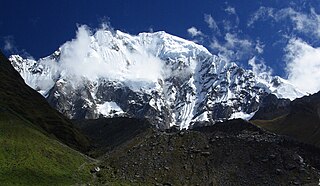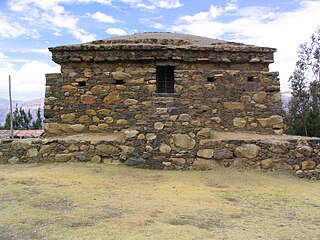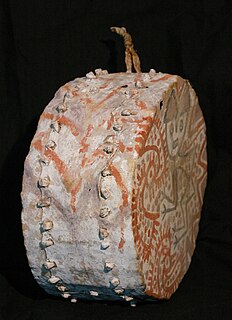
The Vilcabambamountain range is located in the region of Cusco, Peru, in the provinces of Anta, La Convención and Urubamba. It extends between 13°10' and 13°27'S. and 72°30' and 73°15'W for about 85 km.

Huamanmarca is an archaeological site in the region of Cusco, Peru. It is located in Huayopata District, La Convención Province, on the right bank of the Luq'umayu.

Inka Wasi or Inkawasi is an archaeological site in Peru. It is located in the Ayacucho Region, Parinacochas Province, Pullo District.

Inka Wasi is an archaeological site in the Huancavelica Region in Peru. The Inca palace is considered one of the most important monuments of the Huancavelica Region. Inka Wasi is located in the Huaytará Province, Huaytará District, about 25 km from Huaytará. It is situated at a height of 3,804 m (12,480 ft).

Huillca Raccay or Huillca Racay is an archaeological site in Peru located in the Cusco Region, Urubamba Province, Ollantaytambo District. It is situated southeast of the archaeological site Patallacta above the right bank of the little river Pampa Qhawa, an affluent of the Vilcanota River, near the village Chamana.

Willkawayin is an archaeological site in Peru. It is located in the Ancash Region, Huaraz Province, Independencia District, in the village of Paria. It is situated at a height of about 3,400 m (11,200 ft).
Qurimarka is an archaeological site in Peru. It is located in the Cusco Region, Urubamba Province, Ollantaytambo District. It is situated at the river Rayanniyuq (Rayanniyoc) and it belongs to the community Rayanniyuq.
Willka Raymi is a feast celebrated in the Cusco Region in Peru. It is the representation of the traditional offering ceremony to Pachamama. The celebrations are held annually on August (24th) in the archaeological complex of Pisac.

Kunturmarka is an archaeological site in Peru. It is situated in the Ayacucho Region, Huanta Province, Huamanguilla District.
Quriwayrachina, Quri Wayrachina, Hatun Quriwayrachina or Hatun Quri Wayrachina is an archaeological site of the Inca period in Peru located in the Ayacucho Region, Lucanas Province, Carmen Salcedo District. It lies near the mountain Inka Pallanka which is venerated as an apu by the people of the area. There are two platforms which are known as Hatun Quri Wayrachina and Huch'uy Quri Wayrachina by the locals. On April 20, 2011, the site was declared a National Cultural Heritage by Resolución Viceministerial No. 459-2011-VMPCIC-MC.
Quriwayrachina or Quri Wayrachina is an archaeological site with agricultural terraces in Peru. It is situated in the Cusco Region, Anta Province. The terraces lie about 4 kilometres (2.5 mi) north of the terraces of Zurite.
Willkaqucha hispanicized spelling Vilcacocha) is a lake in Peru. It is located in the Lima Region, Huaral Province, Andamarca District.

Huachuhuilca is a 5,315-metre-high (17,438 ft) mountain in the Huanzo mountain range in the Andes of Peru. It is situated in the Arequipa Region, La Unión Province, Puyca District, southwest of Lake Ecma.

Waqra Willka is a 5,066-metre-high (16,621 ft) mountain in the Andes of Peru. It is located in the Junín Region, Huancayo Province, Chongos Alto District. Waqra Willka lies east of Wira Challwa. A couple of small lakes named Yuraqqucha, Anqasqucha, Challwaqucha and Antaqucha are situated at the feet of the mountain.
Hatun Usnu is an archaeological site in Peru on a mountain of the same name (Jatunhosno). It is located in the Ayacucho Region, Huamanga Province, Chiara District.
Inka Raqay hispanicized spelling Incaraqay) or Allqu Willka(Allcuhuillca, Alkowillka) is an archaeological site in the Ayacucho Region in Peru. It is located in the Huanta Province, Iguain District, on top of the mountain named Allqu Willka.
Pusuquy Pata or Ch'illiku Pampa is an archaeological site in the Ayacucho Region in Peru. It is located in the Huanta Province, Huanta District. The site consists of tombs of the Wari culture.
Mulinuyuq is an archaeological site in the Ayacucho Region in Peru. It is located in the Huanta Province.

Inka Paqcha is a mountain in the Andes of Peru, about 4,400 metres (14,436 ft) high. It is located in the Ayacucho Region, Lucanas Province, Carmen Salcedo District. Inka Paqcha lies northwest of Inka Pallanka where the archaeological site of Quriwayrachina is situated.

Huajayhuillca is a mountain in the Urubamba mountain range in the Andes of Peru, with an elevation of 5,361 m (17,589 ft). It is located in the Cusco Region, La Convención Province, Huayopata District, and in the Urubamba Province, Ollantaytambo District. Huajayhuillca lies southwest of Marconi.











